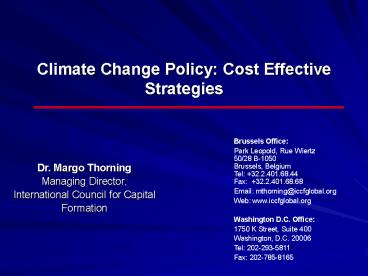Climate Change Policy: Cost Effective Strategies PowerPoint PPT Presentation
Title: Climate Change Policy: Cost Effective Strategies
1
Climate Change Policy Cost Effective Strategies
Brussels Office Park Leopold, Rue Wiertz 50/28
B-1050 Brussels, Belgium Tel 32.2.401.68.44
Fax 32.2.401.68.68 Email mthorning_at_iccfglobal
.org Web www.iccfglobal.org Washington D.C.
Office 1750 K Street, Suite 400 Washington, D.C.
20006 Tel 202-293-5811 Fax 202-785-8165
Dr. Margo Thorning Managing Director,
International Council for Capital Formation
2
Where Does Europe Stand on Actually Complying
with Kyoto?
- European Union is projected to be 7 above the
1990 emission levels by 2010. - EU leaders realize they cannot reconcile goals of
increased EU industrial competitiveness as well
as tighter future targets for GHG emission
reductions. - EU policy-makers are beginning to worry about the
additional steps required to meet the targets
including impact of emission trading schemes on
industry. - Slow EU economic growth hinders reducing energy
intensity (energy used per Euro of output)
3
Greenhouse Gas Emissions in the European Union
Projected to Exceed Kyoto Targets in 2010
Source European Environmental Agency, November
30, 2004
4
The cost of the Kyoto Protocol varies according
to which type of economic model is used
- Sectoral models such as PRIMES(used by DG
Environment) are designed to show the effect of
policy changes on the energy sector rather than
economy wide effects. Primes estimates cost of
Kyoto is 0.12 of GDP in 2010. - General equilibrium models such as that used by
UNICE and the Danish consulting firm COWI are
designed to show the big picture impacts of
policy changes in the long run after the economy
has had time to adjust to energy price changes.
Costs range from 0.7 to 1.5 of GDP in 2010. - Macroeconomic models such as those used by
Oxford Economic Forecasting or Global Insight
are designed to capture the short-run, frictional
costs of adjusting to policy changes. Costs range
from 1.0 to 4.8 of GDP in 2010.
5
Impact of Climate Change Policy on EU
Competitiveness in 2010 General Equilibrium
Model Results
Change
Assumptions Cost of a permit to emit a ton of
Carbon ranges from 55 to 238 depending on rate
of economic growth and speed of new technology
penetration.
Source COWI Report for UNICE, October 2004
6
Impact of Kyoto Protocol and Additional Targets
on GDP In the EU in 2010 and 2020 Macroeconomic
Model Results
Italian Target is a 70 Reduction below 1990 by
2050
Source DRI-WEFA, 2002. www.iccfglobal.org
7
Rapid Growth in Chinas and Indias CO2 Emissions
Projected (Million Metric Tons CO2)
8,000
6,000
4,000
If increase
China
limited to 50
2,000
of baseline forecast
India
0
1990
2001
2025
Base Case Projection Energy Information
Administration,
International Energy Outlook, 2004
8
Limiting Emissions Growth to 50 Would Require
Much Faster Reductions in CO2 Intensity
9
Even Limiting Emissions Growth to 50 Could Have
Big Impact on Per Capita GDP
10
Economic Freedom and the Adoption of New Energy
Technologies
- Economic Freedom Promotes Improved Living
Standards protection of investment, openness of
internal markets, overall share of output
absorbed by government, political freedom - Faster Economic Growth associated with
adoption of new energy technologies which reduces
energy intensity of emissions as living standards
rise - Barriers to new technology
- Pricing distortions
- Lack of markets
- Subsidies through State run enterprises
- Lack of protection for property rights including
intellectual - property
- Restrictions on foreign direct investment
- Lack of infrastructure, education, skills to
handle new - technology
- Import restrictions
11
Economic Freedom Compared to Energy Intensity in
2001
2001
Carbon / GDP
12
Greenhouse Gas Emissions Per Dollar of Output
Million Metric Tonnes Carbon/Billion 1997
13
Comparison of EU and US Energy Intensity
Reduction 1992-2002
1992-1997
1997-2002
1992-2002
US
EU
US
US
EU
EU
14
Practical Strategies to Address Economic Growth
and Climate Change Policy
- Remove barriers to developing worlds access
to more energy and cleaner technology by
promoting economic freedom and market reforms - Increase RD for new technologies to reduce
energy intensity - Develop sequestration through both natural
and man-made technologies - Promote nuclear power for electricity
- Expand bilateral cooperation with developing
countries - Promote a truly global solution

